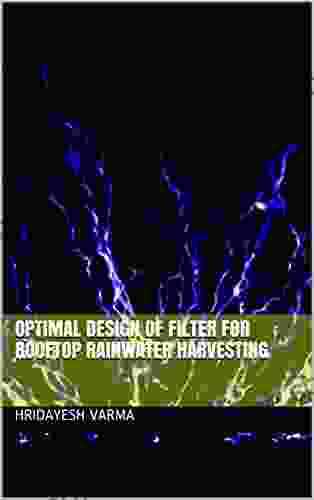The Optimal Design of Filters for Rooftop Rainwater Harvesting: A Comprehensive Guide

Rooftop rainwater harvesting has gained significant popularity as a sustainable and cost-effective method of water conservation. However, it is essential to ensure the collected rainwater is clean and safe for various applications, which requires efficient filtration systems. This article provides a comprehensive guide to the optimal design of filters for rooftop rainwater harvesting systems, encompassing key considerations, filter types, and design parameters.
5 out of 5
| Language | : | English |
| File size | : | 2393 KB |
| Text-to-Speech | : | Enabled |
| Screen Reader | : | Supported |
| Enhanced typesetting | : | Enabled |
| Print length | : | 63 pages |
| Lending | : | Enabled |
Key Considerations for Filter Design
Effective filter design for rooftop rainwater harvesting systems involves careful consideration of several key factors:
- Water quality: The quality of the rainwater varies depending on the location, pollution levels, and roofing materials. Identify potential contaminants and their concentrations to design filters accordingly.
- Flow rate: Determine the required flow rate based on the anticipated rainfall intensity and catchment area. The filter system should be capable of handling peak flow rates without compromising filtration efficiency.
- Particle size distribution: Assess the typical particle size distribution in the rainwater. This information will guide the selection of filter media and pore size to effectively remove suspended solids.
- Hydraulic head: The available hydraulic head for filtration determines the filter's size and configuration. Consider the height difference between the rainwater inlet and the discharge point.
- Cost and maintenance: Factor in the initial cost and ongoing maintenance requirements of different filter types. Choose a solution that balances effectiveness and affordability.
Types of Filters for Rooftop Rainwater Harvesting
Various types of filters can be employed for rooftop rainwater harvesting, each with its advantages and limitations:
- First flush diverters: These devices divert the initial portion of rainwater, which typically contains higher concentrations of pollutants, away from the storage tank.
- Screen filters: Metal or plastic screens with varying pore sizes remove larger particles, such as leaves, insects, and debris, from the rainwater.
- Sand filters: Layers of sand, gravel, and anthracite filter out suspended solids and impurities. They are effective for removing fine particles and turbidity.
- Activated carbon filters: Activated carbon adsorbs contaminants, such as organic matter, chlorine, and heavy metals, improving the water's taste and odor.
- Ceramic filters: Porous ceramic membranes with microscopic pores remove bacteria and other microorganisms, providing high-quality water.
Design Parameters for Filter Optimization
To achieve optimal filter performance, the following design parameters should be carefully considered:
- Filter media selection: Choose filter media with the appropriate particle size removal efficiency and flow rate characteristics.
- Filter bed depth: The depth of the filter bed influences the contact time between the water and the media, affecting filtration efficiency.
- Backwashing frequency: Regular backwashing is necessary to remove accumulated impurities. Determine the optimal backwashing frequency to maintain filter effectiveness.
- Hydraulic loading rate: The flow rate per unit area of the filter bed should be within the recommended range for the selected filter media to avoid clogging and ensure efficient filtration.
- Pressure drop: The pressure drop across the filter should be within acceptable limits to maintain adequate flow rates without imposing excessive pressure on the system.
The optimal design of filters for rooftop rainwater harvesting systems is essential for ensuring the quality and safety of the collected water. By considering key factors such as water quality, flow rate, and particle size distribution, selecting the appropriate filter type, and optimizing design parameters, it is possible to achieve efficient and cost-effective filtration solutions. This comprehensive guide provides a valuable framework for designing filters that meet the specific requirements of rooftop rainwater harvesting systems, contributing to sustainable water management and the provision of clean water for diverse applications.
5 out of 5
| Language | : | English |
| File size | : | 2393 KB |
| Text-to-Speech | : | Enabled |
| Screen Reader | : | Supported |
| Enhanced typesetting | : | Enabled |
| Print length | : | 63 pages |
| Lending | : | Enabled |
Do you want to contribute by writing guest posts on this blog?
Please contact us and send us a resume of previous articles that you have written.
Light bulbAdvertise smarter! Our strategic ad space ensures maximum exposure. Reserve your spot today!

 Arthur C. ClarkeMy Journey with Guruji: Embracing the Transformative Power of Enlightenment
Arthur C. ClarkeMy Journey with Guruji: Embracing the Transformative Power of Enlightenment
 Oliver FosterUnveiling the Treasures of Fortune Knox: A Literary Journey into Intrigue and...
Oliver FosterUnveiling the Treasures of Fortune Knox: A Literary Journey into Intrigue and...
 Philip BellThe Cultural History of Television: Unveiling the Transformative Power of the...
Philip BellThe Cultural History of Television: Unveiling the Transformative Power of the... Owen SimmonsFollow ·15.9k
Owen SimmonsFollow ·15.9k Fredrick CoxFollow ·4.8k
Fredrick CoxFollow ·4.8k Joe SimmonsFollow ·9k
Joe SimmonsFollow ·9k Camden MitchellFollow ·15.9k
Camden MitchellFollow ·15.9k Banana YoshimotoFollow ·11.3k
Banana YoshimotoFollow ·11.3k Andrew BellFollow ·17.9k
Andrew BellFollow ·17.9k Julio CortázarFollow ·9.3k
Julio CortázarFollow ·9.3k Ian MitchellFollow ·8.6k
Ian MitchellFollow ·8.6k

 Isaiah Powell
Isaiah PowellWisconsin Clinic Pilots Mobile Crisis Response System For...
MADISON, Wis. - A new mobile crisis...

 Daniel Knight
Daniel KnightUnleash Your Creativity: A Masterclass in Fabulous Nail...
Embellish Your Fingertips with Captivating...

 Clark Campbell
Clark CampbellDetect When You Are Being Emotionally Manipulated By...
Emotional manipulation is a subtle but...

 Eli Brooks
Eli BrooksNeurological Disorders Papers: Dissociative Identity...
What is Dissociative...

 Ricky Bell
Ricky BellAn Introduction to Islam for Jews: Unveiling the Tapestry...
A Bridge of Understanding: Exploring Islam for...

 Octavio Paz
Octavio PazAchieving Longevity: The Complete Step-by-Step Guide to...
**** In the ever-evolving landscape of health...
5 out of 5
| Language | : | English |
| File size | : | 2393 KB |
| Text-to-Speech | : | Enabled |
| Screen Reader | : | Supported |
| Enhanced typesetting | : | Enabled |
| Print length | : | 63 pages |
| Lending | : | Enabled |












































